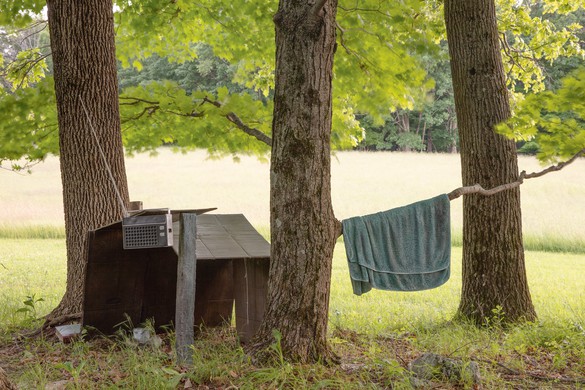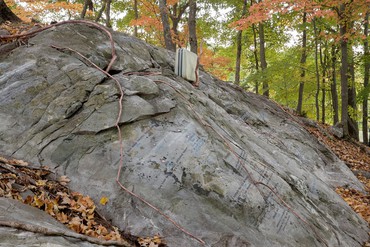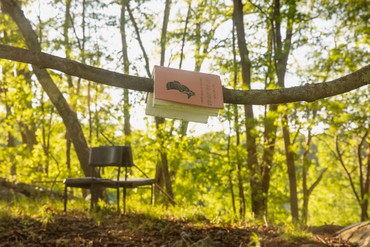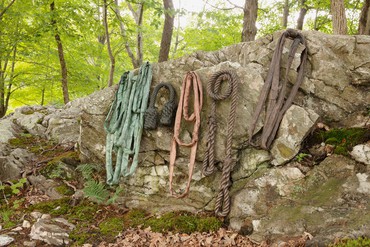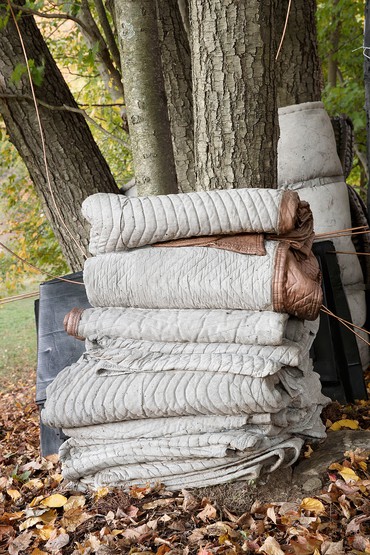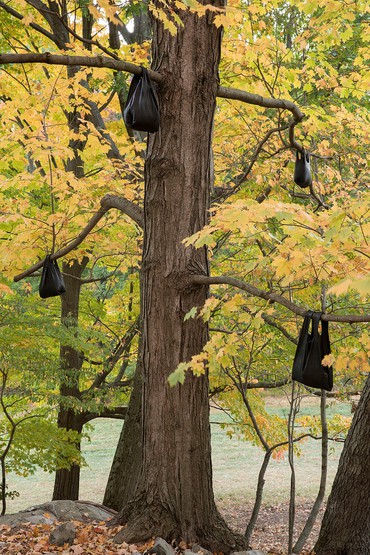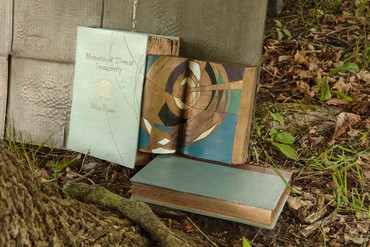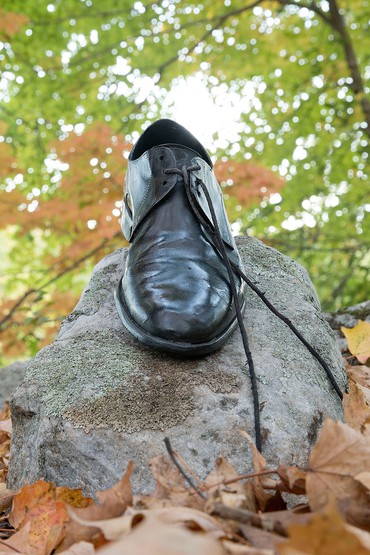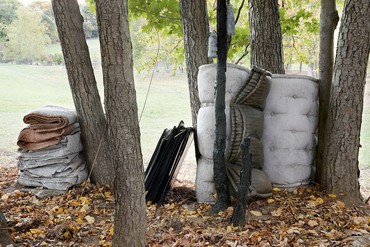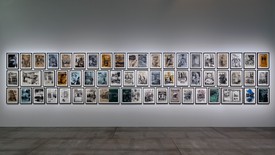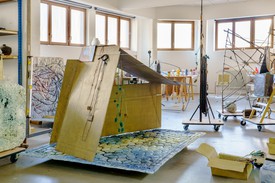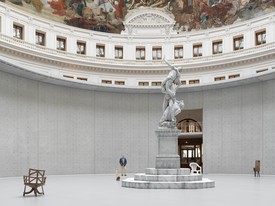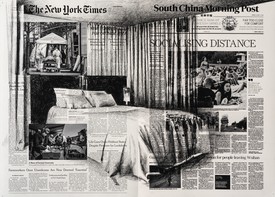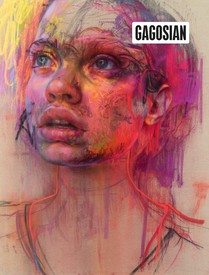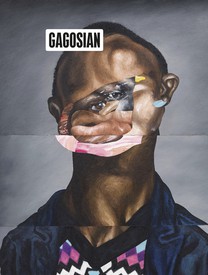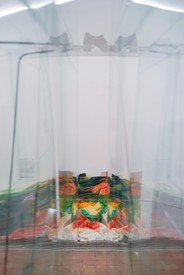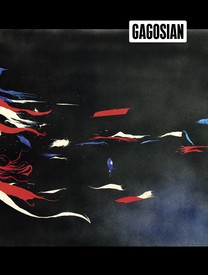
Jenny Jaskey is director and curator of the Artist’s Institute, New York, where she has organized exhibitions with artists including Hilton Als, Tauba Auerbach, Pierre Huyghe, and Carolee Schneemann. She is also distinguished lecturer in the Department of Art and Art History at Hunter College, New York.
I arrived mid-morning as the sun was catching the crest of the hill, making the grass glow an eerie yellowish green. Spring had arrived late this year, we’d all begun to doubt its warmth would ever come, and this shock of green, combined with my groggy stupor—I’d gotten up early to drive a hundred miles north of New York to Dutchess County—made the landscape seem strangely verdant. I live among thick slices of vertical concrete, where trees grow one by one, block by block, and the breeze comes up through subway grates in the pavement. Here I could feel the sky opening up and the earth taking its first gasps of spring air, everything newly awake.
My guide, Matthias, met me near the entrance to the property, some 400 sprawling acres dedicated to a private collection of site-specific commissions. I followed his truck to a barn where I parked my rental. I’d come to see Between sky and earth, by Tatiana Trouvé, an artist whose wide-ranging practice includes sculpture, drawing, and installation but who is known in recent years for constructing elaborate mise-en-scènes rich in psychological and material intrigue. Trouvé often radically transforms the interiors of the spaces in which she works—cutting into floors, creating passageways and hidden rooms, changing the expected scale of windows and doors—then arranges sculptural objects within these environments to create the impression that something of consequence (but what, exactly?) has taken place or is just about to. The strategy recalls the film noir convention in which the detective appears in medias res, has only fragments of information to work with and a client who may or may not be reliable, and must determine what is real and what is false. Unlike detective fiction, though, Trouvé’s immersive installations leave viewers in the middle indefinitely—between real and imagined, past and future, in a kind of uncanny, fragmented surrealism.
I’d anticipated this trip with more than a little curiosity, since Trouvé has rarely shown in the United States and it is rarer still to see her work outdoors. Her major installations have mostly appeared in European institutions, including ambitious solo exhibitions at the Palais de Tokyo, Paris; the Migros Museum, Zurich; MAMCO, Geneva; the Kunsthaus Graz; and the Schinkel Pavillon, Berlin, as well as in international biennials, among them Venice, Istanbul, São Paulo, and Lyon. Her first solo project in New York was in 2010, a site-specific installation that transformed several galleries at Gagosian, and in 2015, commissioned by the Public Art Fund, she created Desire Lines, a huge sculptural archive at the edge of Central Park that connected the park’s official and unofficial pathways with walks of historic and literary significance. I’d heard that this upstate commission, begun in 2012, was different from anything Trouvé had attempted to date—unique in its engagement with a dynamic natural environment over time, and referencing key works of hers from other times and contexts.
We mounted a black ATV and drove up a dusty path that cut through an expanse of fields. The path narrowed as we entered a patch of woods and we stopped at a grove of trees nestled on a small rocky hill. Quiet and shaded, it was the sort of place that you might look for to rest in after a long hike, or where, as a child, you and your friends might have played fort.
I spied a couple of weathered mattresses, folded and stuffed between a cluster of trees. Beside them sat a stack of broken-down and blackened cardboard boxes. There was a pile of heavy gray moving blankets too, and, above those, a couple of crusty used water-bottles tied with twine to a tree trunk. Everything looked weathered, grayed and browned, giving the impression of use, though how long this mysterious user had been away—a few weeks? years?—wasn’t clear. Moving around the objects, I noticed a handful of copper rods sticking out like skewers from the blankets and cardboard, the first tell that all was not as it appeared. More copper caught my eye in the trees, and Matthias remarked, “Yep, we had a grapevine infestation here.” We looked up together at Trouvé’s sinewy doubles of grapevines, cast in copper and hanging believably among the branches above our heads. Two black tree trunks nearby, which a moment ago had looked dead from rot or a brush fire, were the first thing I touched. Like all of the other objects I would see placed among the living, they looked ordinary but were in fact artworks, in this case cast in bronze.
by placing these sculptures in an environment whose conditions change with the season, the weather, or the time of day, Trouvé intensifies their existence in both the time of the natural world and a distinctly human dimension.
I continued onward, passing a handful of apparently discarded wooden crates and a sawhorse with a headlike stone. Then, in a small clearing, I came upon three fire hoses and a thick dark rope hanging limply on the face of a large rock. To the right was what could have been a child’s makeshift fort: a hastily constructed cardboard shelter, with a radio hanging off one side and an old towel set out to dry on a branch nearby. These objects, especially the towel, were the surest signs of habitation, yet no obvious narrative could be constructed from the available evidence.
Trouvé spent part of her childhood in Dakar, Senegal, where local folklore tells of djinns, supernatural beings that dwell in all manner of objects—rocks, trees, the earth, or air. What interests Trouvé about these mythic creatures, which she referenced directly in her exhibition Djinns, at Cneai, Paris, in 2005, is the way their presence is sensed but not seen. The animism of the djinn involves an enlivening of objects that are on the one hand material and on the other psychic. In Dutchess County a djinnlike presence, an aura of the metaphysical, lingered most palpably around two black chairs I saw, placed back-to-back on a flat plane of rock a distance from the cardboard fort. Each chair appeared to have a padded leather seat, and a long thin copper rod rested flat on one of them and against a side of the other. I recognized the objects as sculptures in Trouvé’s series The Guardian (2013– ). In the visual language of those works, copper rods are a stand-in for a sentinel watching whatever the assembled installation may be, but who has left the premises for an unknown period. This guardian is both here and not here, a felt presence marked materially but never fully embodied. Trouvé returns to this way of working time and again, making things that sit between matter and memory, or, as she describes it, “on the threshold of a physical and mental experience.”1
Like the Guardian works, many of the objects in the woods are familiar forms from other Trouvé installations. She has used casts of mattresses, shoes, blankets, and boxes before. Yet by placing these sculptures in an environment whose conditions change with the season, the weather, or the time of day, Trouvé intensifies their existence in both the time of the natural world and a distinctly human dimension, in both a dynamic ecosystem and our ever-changing memory-scape. Working in a white-walled gallery, Trouvé may defamiliarize our sense of time and place by altering a room’s architectural scale, or the way we move through it in space. Here in the woods, changes in architecture—an organic architecture of trees, rocks, and leaves wedged between sky and earth—are interventions among living things, hybrids of organic forms and man-made ones: a bronze copy of a tree beside a living tree, copper bricks wedged between rocks, a copper rod stuck in the ground through which the sounds of organisms deep in the earth can be heard. The latter is part of a work-in-progress on the site, a meridian sculpted on a rock that points to high noon. In addition to solar time, the piece will also have a lunar dial that will come to life when the moon is full. With this object and with the entire installation, Trouvé has found a way for things to reveal themselves differently in time, to be both durable and in process.
One of the most remarkable aspects of the work’s relation to time is an area on the back perimeter of the site where large flat boulders cover the ground. Etched on the surfaces of the rocks are dozens of captions of artworks, formatted like wall labels in a gallery: “A Suitcase that Packs and Unpacks Itself, 2005, logic of wandering”; “Prepared Space, 2063, patinated bronze, wood, incision in the floor and walls, dimensions variable”; “Mister, Mrs. Miss., Tatiana Trouvé, 1990–2025.” Above each entry the artist has pressed copper disks the size of pennies, turning the rocks into a kind of hybrid sculptural form that merges geological time with the discrete periods in which Trouvé’s artworks have or will have appeared. Combining the visual cues of a monument or gravesite with inscriptions memorializing the to-yet-occur, Trouvé’s archive in the landscape manages to overlay time in its varied registers. In many ways this work harks back to one of her earliest and best-known projects, Bureau d’Activités Implicites (Bureau of implicit activities, 1997–2007), a series of thirteen architectural modules recording various activities—activities that might otherwise be seen as wastes of time—in a highly aestheticized way. One of these modules, Module administratif (Administrative module, 1997–2002), takes the form of an office cubicle containing an expanding archive of documents related to the administration of Trouvé’s art practice: grant applications, CVs, rejection letters. Another, Module à reminiscence (Reminiscence module, 1999), consisted of a sealed, mirrored cylinder containing archived memories written on scraps of paper. Between sky and earth is a new, site-specific archive that puts everything outside, etched permanently in stone, yet still manages to evade full disclosure, the artist herself the sole guardian of the imagined future works she promises will one day become memories.
Trouvé has said that she plans to keep working on Between sky and earth indefinitely. Since she began this site-specific project, she’s made a dozen or more visits to it, and in addition to the sundial is developing new elements for the trees. Earlier documentation reveals that the fire hoses, a set of birds’ nests, and a pile of books are all new additions since the first objects were installed. This commitment to long-term engagement with the work seems crucial to the ideas Trouvé sets out in it. Since the early days of her practice, she has insisted that “waiting time” is productive, and her work can be seen as trying to give physical form to the act of simply being in process, of becoming a subject.2 Here, with every new element added, Trouvé is subtly changing what we confront, but also what we remember from a past visit, or what kind of story we might construct from the elements. What will Between sky and earth become? We have to wait and see.
1Tatiana Trouvé, quoted in an unsigned Gagosian press release, 2010. Available online at gagosian.com/exhibitions/2010/tatiana-trouve/ (accessed July 25, 2019).
2“I believe these waiting moments are quite productive. In this waiting time there is a construction of the self, of the subject.” Interview with Francesca Pietropaolo, “In the Studio: Tatiana Trouvé,” Art in America, March 2010. Available online at www.artinamericamagazine.com/news-features/magazines/tatiana-trouv/ (accessed July 31, 2019).
Artwork © Tatiana Trouvé; photos: Guillaume Ziccarelli
